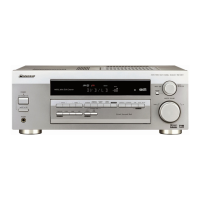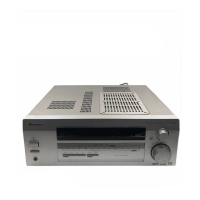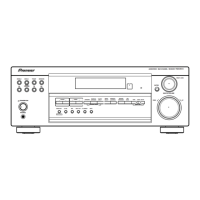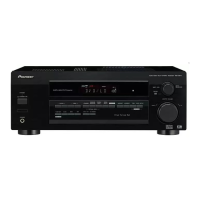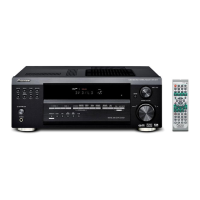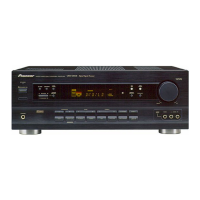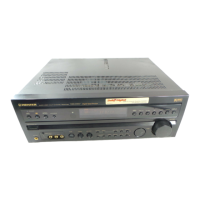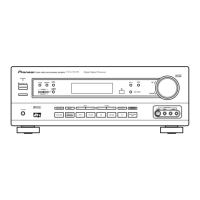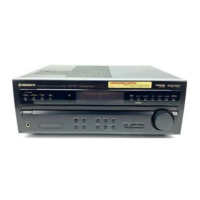Do you have a question about the Pioneer VSX-D512 and is the answer not in the manual?
Covers electrical safety, water exposure, flammable materials, mains connection, and standby power precautions.
Warning about hazardous voltage at speaker terminals and risk of electric shock.
Guides on how to hook up DVD player and TV for a basic surround sound system.
Instructions for connecting speaker configurations and notes on impedance.
Guide to connecting front, center, surround, and subwoofer speakers to the receiver.
Tips for optimal speaker placement to achieve the best surround sound effect.
Safety precautions for handling the power cord to prevent electric shock or fire hazards.
Explains the various indicators on the receiver's display screen and their meanings.
Identifies and describes the functions of various buttons on the remote control.
Overview of basic sound options: Stereo/Direct, Standard, and Advanced Surround modes.
Details on Standard, Pro Logic II Movie, Pro Logic II Music, and Pro Logic modes for surround sound.
Descriptions of Movie, Music, and Virtual Surround Back effects for enhanced audio.
Steps to play back multi-channel audio sources like Dolby Digital or DTS.
How to cycle through and select Advanced Surround listening options.
Steps to select the DVD 5.1 channel input for multi-channel analog playback.
Introduces the process of configuring speaker settings, subwoofer, and other parameters.
Specifies how to configure front, center, and surround speaker types and sizes.
Adjusts individual channel volume levels for optimal surround sound balance.
Lists common operational issues and their remedies, such as no power, no sound, or noise.
Addresses issues like no surround sound, cassette noise, display darkness, and remote control problems.
Lists power output, frequency response, and impedance for amplifier and video sections.
Covers electrical safety, water exposure, flammable materials, mains connection, and standby power precautions.
Warning about hazardous voltage at speaker terminals and risk of electric shock.
Guides on how to hook up DVD player and TV for a basic surround sound system.
Instructions for connecting speaker configurations and notes on impedance.
Guide to connecting front, center, surround, and subwoofer speakers to the receiver.
Tips for optimal speaker placement to achieve the best surround sound effect.
Safety precautions for handling the power cord to prevent electric shock or fire hazards.
Explains the various indicators on the receiver's display screen and their meanings.
Identifies and describes the functions of various buttons on the remote control.
Overview of basic sound options: Stereo/Direct, Standard, and Advanced Surround modes.
Details on Standard, Pro Logic II Movie, Pro Logic II Music, and Pro Logic modes for surround sound.
Descriptions of Movie, Music, and Virtual Surround Back effects for enhanced audio.
Steps to play back multi-channel audio sources like Dolby Digital or DTS.
How to cycle through and select Advanced Surround listening options.
Steps to select the DVD 5.1 channel input for multi-channel analog playback.
Introduces the process of configuring speaker settings, subwoofer, and other parameters.
Specifies how to configure front, center, and surround speaker types and sizes.
Adjusts individual channel volume levels for optimal surround sound balance.
Lists common operational issues and their remedies, such as no power, no sound, or noise.
Addresses issues like no surround sound, cassette noise, display darkness, and remote control problems.
Lists power output, frequency response, and impedance for amplifier and video sections.
| Channels | 5.1 |
|---|---|
| Power Output (per channel) | 100 W |
| Total Harmonic Distortion | 0.09% |
| Input Sensitivity | 200 mV |
| Input Impedance | 47 kΩ |
| Surround Sound Formats | Dolby Digital, DTS |
| Weight | 21 lbs |
| Type | AV Receiver |
| THD | 0.09 % |
| Speaker load impedance | 6 - 16 Ω |
| Digital inputs | 1 x coaxial, 1 x optical |
| Video inputs | 3 composite |
| Video outputs | 1 x composite |
| Frequency Response | 5 Hz - 100 kHz |
| Output | 100W per channel |
